Have you ever wondered how OTT platforms like Netflix, Disney+, and Amazon Prime make so much money just by streaming videos?
The secret is their OTT business model, which helps them earn billions and stay successful.
In 2025, the global OTT video market is projected to generate revenues of approximately $343.80 billion.
As more people start using OTT platforms, the competition is getting tougher. These platforms use different ways to make money, like subscriptions, advertisements, or a mix of both.
But which one works the best, and why?
In this blog, we will explain the best OTT revenue models for 2025 and how they are changing the future of streaming. Let’s get started!
The Best OTT Revenue Model for Maximizing Profitability in 2025
The Over-The-Top (OTT) media landscape has drastically transformed, establishing itself as the primary global entertainment source.
The global OTT market is anticipated to be more than $1 trillion by 2023, driven by high-speed internet access and the trend towards on-demand content consumption.
A variety of income models, including Subscription Video on Demand (SVOD), Transactional Video on Demand (TVOD), Advertising-Based Video on Demand (AVOD), and Hybrid Models, are used by the platforms to ensure their sustainability and provide different content types targeting different audiences.
This article presents the main OTT business models, analyzes the good practices from such giants’ platforms as Netflix, YouTube, and Amazon Prime Video, and comes up with ways to effectively generate revenue from OTT.
It is meant to be a raster for companies and creators who come to terms with this inconsistent ecosystem.
Which OTT revenue model is best for new platforms in 2025?
For new OTT platforms launching in 2025, a hybrid revenue model combining AVOD and SVOD is often the most effective. Starting with ad-supported content (AVOD) helps attract a large audience quickly, while gradually offering premium subscriptions (SVOD) creates a steady income stream. This approach balances audience growth and revenue generation in a highly competitive streaming market.
Key Takeaways
- The AVOD model allows platforms to generate revenue through advertisements while providing free access to users, making it a popular OTT revenue model.
- SVOD ensures consistent income through subscriptions, suitable for platforms with high-quality, engaging content.
- TVOD operates on a pay-per-view basis, appealing to audiences seeking exclusive content on an revenue model of OTT platform.
- Hybrid models leverage multiple approaches, allowing platforms to tap into diverse revenue streams and adapt to market demands.
- Strategically choosing an OTT business model ensures long-term platform growth and audience retention.
Before we dive deeper into each model, here’s a quick comparison to help you understand how they differ in strategy, audience, and monetization potential:
| Revenue Model | Description | Best For | Examples |
| SVOD (Subscription Video on Demand) | Users pay a recurring fee (monthly or yearly) for unlimited access to content. | Premium or niche content platforms with loyal audiences. | Netflix, Disney+, CuriosityStream |
| AVOD (Advertising Video on Demand) | Content is free to watch but supported by ads before or during playback. | Mass-market platforms targeting wide, cost-sensitive audiences. | Tubi, Pluto TV, YouTube |
| TVOD (Transactional Video on Demand) | Users pay per view or download of individual content (rent or own). | Exclusive events, films, or one-time content. | iTunes, Amazon Prime (rentals) |
| Hybrid (SVOD + AVOD) | Combines subscription and ad-supported content in one platform. | Platforms seeking both reach and stable recurring revenue. | Hulu, Peacock |
Statistics for OTT Revenue Model 2023 to 2030
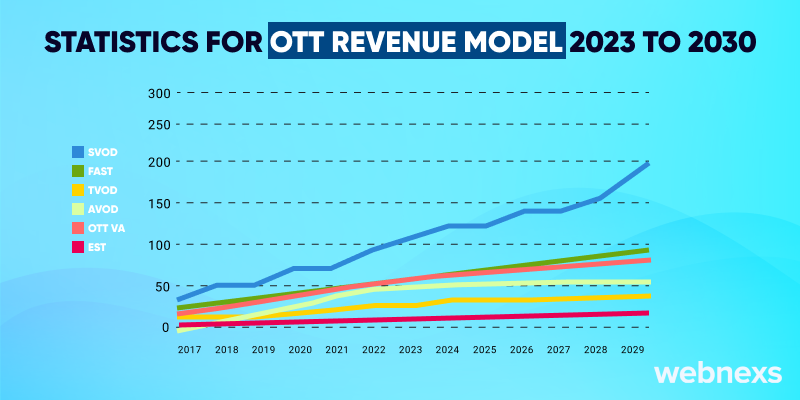
Market Growth: The global OTT market is seen to go up from around $60 billion in 2023 to about $200 billion by 2030 which means CAGR has been projected at 20%.
Subscription-Based Revenue: Subscription Video on Demand (SVOD) is the chief model that will contribute around 70% of the revenue from OTT services by 2030. Next year, the SVOD connections will hit 1.5 billion people around the world.
Ad-Based Revenue: With $30 billion revenue in 2023, advertising video on demand (AVOD) platforms are also likely to grow substantially, reaching $60 billion in 2030. This marks a transition as companies are turning to OTT platforms as a medium to reach out to the audience as they move from the traditional one which has been the mainstream for years.
Transactional Revenue : While Transactional Video on Demand (TVOD) is expected to have a smaller market share compared to SVOD and AVOD, it is going to take a revenue hike from $10 billion in 2023 to $20 billion by 2030, approximately.
Regional Insights: North America is expected to be the largest market for OTT services, with an increase in Asia-Pacific and Europe; these ranges are primarily due to increased mobile device and internet usage.
Content Spending: By 2030, streaming platforms are about to inject around $200 billion into the market by creating and purchasing content, not only intensifying the competition among streaming platforms but providing a greater range of content as well.
Consumer Behavior: In the year 2025, more than 70% of households in the developed countries would have a monthly subscription to at least one OTT service that provides library-like on-demand content, rather than a streaming TV service.
Best OTT Revenue Model For Your OTT Platform

Video on Demand(VOD) is a system that allows viewers to select and watch video content of their choice through TVs, computers, and mobile devices. Individuals can assign or choose their interesting video content based on their preferences, all assisted by advancements in technology.
70% of consumers now trust streaming subscriptions provide better services than traditional TV
The term strike to represent this era in entertainment and media is video-on-demand or VOD
Eg. We can watch movies, live shows, and programs anywhere, anytime on YouTube Netflix, Amazon Prime Video, HBO, Disney+, etc.
- Advertising VOD(AVOD)
- Subscription VOD(SVOD)
- Transactional VOD(TVOD)
“AVOD” platform
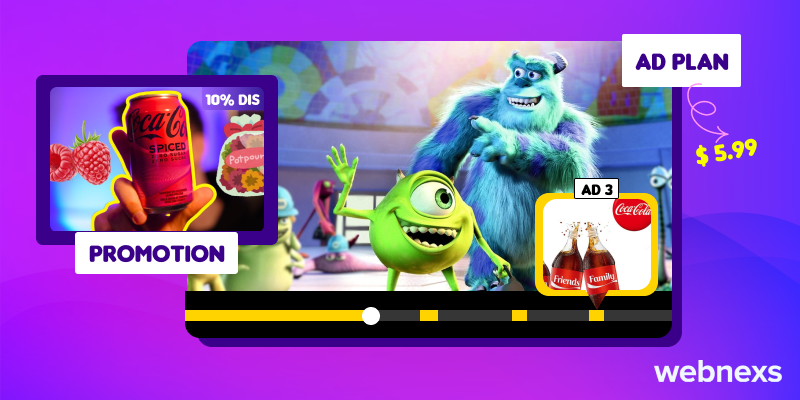
Advertising video-on-demand(AVOD) is ad-based video content, involving free access to their users for watching, while website owners can get monetized via their ads posted.
This is free for the consumers increasing viewership and subscriptions, while advertisers pay for the channels/business. There are different types of ads involving pre-Ads, post-Ads & Mid -Ads.
Eg. YouTube is one best example, more of a sort of advertising platform where users pay nothing while advertisers keep supporting the business.
The most popular and successful AVOD platform for video creators is YouTube, where ads come in the form of:
- These ads can take various forms such as pre-roll ads that play before the video.
- Mid-roll ads that pause at strategic points throughout the content
- In-video ads that appear on the screen during video playback.
Statistics here:
- 96.5% of YouTubers struggle to earn above the poverty line.
- YouTube takes nearly half of a creator’s ad revenue.
- In order to be eligible for YouTube’s AdSense program, a YouTube channel must have at least 1000 subscribers and 4000 valid watch hours in the past year.
Benefits of “AVOD” platform
- It offers more services and content absolutely at a zero-cost basis.
- It delivers viewers valuable and entertaining content based on their choice sets.
- Improve audience base absolutely at zero cost, while advertisers pay.
Read More: 5 Best Video On Demand Platforms (VOD) In 2022
“SVOD” platform

Subscription video-on-demand(SVOD) is a subscription-based service delivering video content for their viewers, choosing their packages.
These payments can be collected either monthly, half-yearly, or quarterly basis based on the viewer’s preferences. It is compatible with the consumer’s budget for getting more services in a single click.
Eg. Netflix provides video content based on a subscription.
- With nearly 190 million subscribers worldwide, Netflix is ranking in a significant amount of money each month.
- Taking an average of $6 per subscriber per month, the subscription-based video streaming giant earns over $1 billion monthly and more than $12 billion annually.
- With such high revenues, the production of series and movies need not be too costly for this industry leader.
Benefits of “SVOD” platform
- Repeat purchases of video content by viewers keeping a steady flow of revenue.
- Users can change subscription packages based on their preferences.
- More package availability allows flexible subscriptions & increased revenue flow.
“TVOD” platform
Transactional video-on-demand is a model where viewers can buy or rent content on a pay-per-view basis. It involves purchasing a single content for a specific amount especially involving recent releases, cricket matches, etc.
Eg. Hotstar and Amazon Prime Video deliver movies/series to users allowing them to purchase a single content.
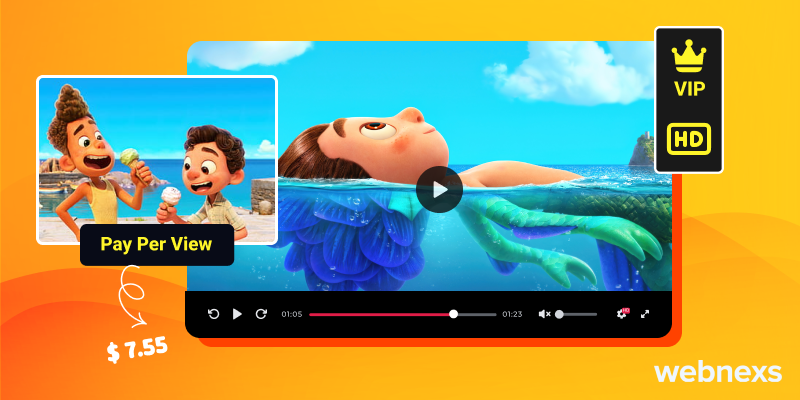
Learn more about it by checking out these important amazon Prime Video statistics:
- 200 million is the number of active subscribers worldwide on Amazon Prime Video
- 66% of people from the U.S. aged 35 to 44 years old currently subscribe to Amazon Prime Video
- Amazon Prime Video has been ranked as having the second largest choice of original content, behind only HBO Max and ahead of Hulu, according to surveys conducted among US adults.
Benefits of “TVOD” platform
- Viewers can only pay for particular content regarding their preferences.
- It delivers cash-to-value services and meets customer satisfaction.
- TVOD generates adequate revenue within a short period.
Hybrid Model
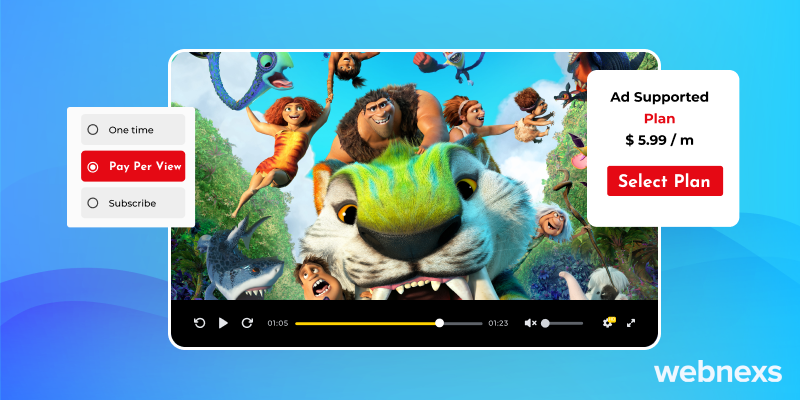
The popularity of the hybrid OTT revenue model is accelerating due to its ability to monetize content via several ways and attract a wider audience.
Mixing premium content behind the paywall with free ad-supported content is a great step for platforms to effectively reduce subscriber churn and enhance customer lifetime value.
Benefits of the Hybrid Model
- Greater Audience Reach: A larger audience gets drawn in, including both free and paid users.
- Enhanced Revenue Streams: Revenue will come using both marketing and subscriptions.
- Increased User Engagement: By supplying a range of materials, viewers spend more time viewing it.
- Advertisers find it appealing since it allows them to reach a larger and more engaged audience for more focused advertising.
Generally speaking, each of the primary categories of the hybrid approach are Video on Demand (VoD) and subscription-based content. The business strategy of these services enables both to depend on subscriptions and make monthly payments watching, allowing customers to access some content for free and others only for a fee.
Accelerate Your Growth with a Winning OTT Revenue Model!
Exploring the OTT Revenue Model in the Digital Landscape

1. Video Space – Hosting & Monetization Platforms
This model works on its main feature to provide video content and the distribution of video via different platforms, thus it falls on the cost of the revenue model which is chosen.
SVOD (Subscription Video on Demand)
Users pay down a month-to-month or yearly fee (monthly or yearly) for unlimited access to a video library. The service plans ensure the revenue by building a subscriber base.
TVOD (Transactional Video on Demand)
Viewers pay individual fees to access a specific video or content, which are often created in one-time events or during high seasons. A result is based on the number of individual purchases.
AVOD (Advertising Video on Demand)
Content is free to view, and in return, the platform displays them on the screen. The money reaped by the platform comes from the ads it shows.
Advertising video on demand is the best solution for such customers because, with a significant number, a variety of ads can be brought up thus the profitability comes from them being the only source of revenue for TV.
White-label OTT Services
OTT services Colombia is rented through cloud or server hosting to develop personalized video platforms. Businesses benefit from the fact that they do not have to develop the platform and they are flexible and adaptable without spending the platform development costs in the first instance when they rent the cloud or server hosting.
2. Selling Space – Ad Space or Digital Slots
One method to make money is to offer spots on streaming sites or websites for commercial sale.
Ad Slots on Streaming Platforms
Some spots are provided by the platform and there’s the possibility for the advertisers to pick which spot they want.
For which they can use the analytics data of the platforms in case of targeting to make the delivery of campaigns in a better way.
Renting Ad Space
Companies that want to promote their products rent ad spaces on apps, websites, or video platforms but instead of having the ads managed by a third party ad platform, they do it themselves to get more reach and earnings.
Sponsorship Packages
Sometimes companies work with the advertising agencies in developing custom sponsorship packages to exactly meet advertisers’ needs, granted it could be done through many different companies including ads, product placement, and branded content doctored according to advertiser’s needs.
Based on Geography
Geographic targeting is the process of selecting the ad placements according to the customers’ locations or cities. In this way, we reach people near the areas they prefer to buy food which in turn can result in purchases.
Whereas, a local restaurant can refine its advertising strategy to reach potential customers effectively by using geo-targeted ads.
Based on Gender
A certain ad targeting method comprises tailoring creating content that contains gender-specific elements.
The streaming ott platforms get a demographic analysis that helps to understand the audience’ preferences, which in turn is helpful for the manufacturers to produce messages that will capture the clients’ attention and act as a stimulus for the purchase or to sign in.
Based on Viewer Cookies
Utilization of viewer cookies is essential to efficient advertising. Cookies trace the user behavior, offering insights into audience interests. This information allows advertisers to create specific campaigns that enhance user experience and maximize ad efficacy.
3. Selling Tickets for Events – Hybrid or Virtual Events
Revenues can be made from ticket sales for both virtual and physical events, and the use of hybrid technology can be employed to facilitate audience participation.
Event Ticketing Platforms:These platforms represent a means of selling tickets for virtual or live streaming events. It is made easy through the processing of payments and the management of attendee interaction.
Hybrid Events: This kind of event fuses in-person and virtual attendance, and people who are also away can log in from their end as well. This arrangement indicates the possibility of a larger audience and the better chance to sell premium tickets and items.
Use Case
Maximizing Revenue through Country-Level and City-Level OTT Models for Rugby
OTT services can make money with rugby programming in countries and cities by creating ways to attract regional audiences, fan bases and sponsors. This requires them to model the monetization in a fashion that meets the interest of the specific regions.
1. Country-Level OTT Revenue Models for Rugby
Subscription-Based (SVOD)
A SVOD platform service provider can host rugby tournaments that are only available through subscription on a local or international level.
Example: Exclusive access to Six Nations or the Rugby Championship matches.
Advertising-Based (AVOD)
Platforms insert commercials both in live broadcasts and highlight reels that are targeted specifically at national companies whose products are loved by football fans.
Example: A telecom or a beverage company that sponsors the World Cup can show their advertisements during the games.
Pay-Per-View (TVOD)
People get to pay their way to watch these events, such as finals or single nation games where their country’s team is involved, as a result of participating in events leveraging Pay-Per-View (PPV) technology.
Example: The final match of the Rugby World Cup to be offered only on a pay-per-view basis.
Hybrid Model
The service incorporates an SVOD and an AVOD model that operates as a two-tier structure. The users will first be exposed to video highlights with some adverts, and for the entire ad-free version, they will need to subscribe.
2. City-Level OTT Revenue Models for Rugby
Local Club Subscriptions
OTT platforms can give exclusive access to city-level or local club rugby leagues through cheap subscriptions made for the lovers of regional teams only.
Example: The payment made for accessing the league in Cape Town or Sydney would qualify one for the subscriptions.
Regional Sponsorship Ads
Local firms spend their promotional monies on OTT platforms and limit the marketing of their services to rugby lovers localized in certain cities or regions.
Example: The store specializing in sports gears within the city came on board to support local rugby match streams.
Merchandise Sales via OTT Integration
OTT platforms are also introducing e-commerce to enable local fans to buy club gear and other game-day kits while streaming games live.
Live Event Passes (TVOD):Fans pay for access to the streams of such matches.
Example: Seeing a derby match between coasted cities.
Why Country and City Segmentation Matters In 2025
OTT platforms, by the use of various methods such as personalization, could earn the big bucks with the provision of services in both national and local market levels.
Large national ones have the advantage of achieving commercial success because of the larger audiences while local content helps in building loyalty and also enables the attraction of regional advertisers hence the creation of a multiplicity of revenue streams.
Revenue Generation Opportunities for Conferences on OTT Platforms
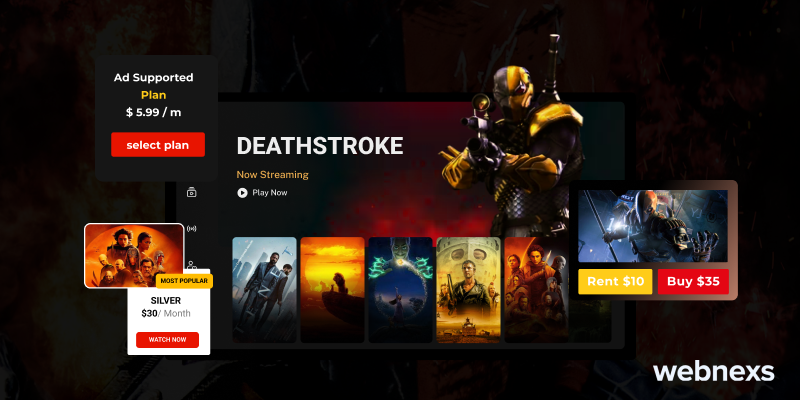
Using OTT platforms to host video conferences can lead to an excess of ways that can be explored to earn money, which includes the broadening of the target audience, unique access provision and utilizing a plethora of monitory methods. Here is the potential of using OTT conferences to make revenues:
Ticketing& Registrations
Set price for tickets (USD) at $60-$120 ( ₹5,000-10,000 )or offer a pay-per-session choice to take participants’ money, and with the former, organizations can make some more money.
Besides this, the provision for different packages according to the user requirements in addition to the basic one and tax benefits for companies which include free tickets for employees are the possibilities.
Sponsors and Partners
Together with a couple of the biggest companies of the world, you can produce programs either online or simply by using virtual reality.
A company can generate $6,000-$24,000 (₹5-20 lakh) from sponsorship revenue per company.
Advertising Revenue
Customers are entertained by the ads they watch in the course of the program following a scenario.
You will be given the dividends of ₹200-400 for every 1,000 views which the ads shown at an interval of time in the breaks are viewed. This means you are getting small amounts of money in a period of time!
On-Demand Content (VOD)
Some of the usual options could be providing the VOD for ₹1000 per session or the bundle access for the customer’s convenience.
Premium Networking Opportunities
Offer exclusive networking sessions or virtual meet-and-greets with speakers, with VIP passes priced between ₹5,000-15,000 ($60-$180). These sessions enhance attendee engagement and drive additional revenue.
Maximizing Revenue for College Conferences Using an OTT Revenue Model
For a college conference, generating an over-the-top revenue from a platform entails the vertical utilization of various digital strategies and monetization models to optimize not only audience but also financial returns.
First and foremost, college conferences can effectively generate income if they decide to follow the OTT model:
1. Subscription-Based Streaming (SVOD)
- Strategy: One of the potential approaches to this program is to introduce a service where students who have paid for a live-stream event can listen to the presentations, the debates, and the workshops hosted there.
- Revenue Potential: Collect the fee from students, faculty, and alumni on a monthly or yearly basis, e.g., ₹200-500/month ($2.50 – $6). With 1,000 subscribers, the possible monthly revenue is up to ₹2,00,000-5,00,000 ($2,500 – $6,000) a month.
2. Pay-Per-View (TVOD) for Special Events
- Strategy: Stipulate a pay-per-view plan that is specifically designed for particularly exclusive or celestial events like guest speakers or graduation ceremonies.
- Revenue Potential: The charges for access can be ₹100-300 ($1.20 – $3.60) per view. If 2,000 people purchase access, this could make a profit of ₹2,00,000-6,00,000 ($2,500 – $7,200).
3. Sponsorship and Brand Partnerships
- Strategic: Team up with local enterprises, national brands and schools for sponsorship contracts. In return, they can be offered brand placements in streams and during the promotion of the event.
- Revenue Potential: These could potentially be from ₹50,000-5,00,000 ($600 – $6,000) per event and they depend on the viability of the sponsor and the number of attendees.
4. Advertising Revenue (AVOD)Strategy
We should scatter advertisements within the conference streams. This may embrace pre-roll ads, mid-roll ads, or sponsored segments.
- Revenue Potential: With ₹200-500 CPM (cost per thousand impressions), if the conference attracts 100,000 views, it could generate ₹2,00,000-5,00,000 ($2,500 – $6,000) from ad revenue.
5. Merchandise Sales
- Strategy: Sell conference-related articles (e.g., branded apparel, conference materials, or memorabilia) via the OTT platform.
- Revenue Potential: If 500 items are sold at an average price of ₹500 ($6), it could generate ₹2,50,000 ($3,000) in merchandise sales.
6. Crowdfunding and Donations
- Strategy: Start the crowdfunding drive or else, seek donations from the alumni and supporters during the live events. Besides, donors can also be given special perks such as being able to access the behind-the-scenes content or VIP sections.
- Revenue Potential: A successful campaign could raise ₹5,00,000 ($6,000) or more, depending on the alumni network’s engagement.
7. Affiliate Marketing Programs
- Strategy: Associate their services with the conference by making partnership with the publishers of relevant educational platforms, book publishers, or tech companies. By doing this, one can earn a commission on sales generated through referral links.
- Revenue Potential: If the conference drives ₹3,00,000 ($3,600) in affiliate sales, the revenue share could be significant.
8. Educational Content Sales
- Strategy: Capture and process conference sessions post-event. Users get access to the abovementioned stills or learn the video material by being able to see it in real-time or by the so-called courses post-conference.
- Revenue Potential: The sale of records of the entire conference at ₹500 ($6) per download may bring in enough income to cover the revenue deficit in the face of the higher amount of need!
9. Hybrid Ticketing Model
- Strategy: Propose and regularly combine a faceted registration model, where the customer can either attend in person or via the OTT. Charge for both.
- Revenue Potential: Provided that 500 attendees take part in the live event registering at ₹1,000 ($12), it could earn the producer ₹5,00,000 in addition to ad-ons for other businesses getting OTT subscriptions.
10. Engagement Features and Interactive Experiences
- Strategy: Try to allow attendees to take part in the event through the event platform and simultaneously use live polls to get the public to interact, Q&A sessions to get the audience to ask more questions to the panel and at the same time to show the public where and how to network virtually. Optionally, require an entry fee for this.
- Revenue Potential: Thus, selling premium entry at ₹100 to ₹300($1.20 – $3.60) with a percentage of the overall revenue coming from user engagement would be the thing to do.
Example Revenue Projection
Assuming a college conference has 3,000 attendees and incorporates the strategies mentioned:
Subscriptions: 1,000 subscribers at ₹200/month → ₹2,00,000/month ($2,500)
Pay-Per-View: 2,000 views at ₹150 → ₹3,00,000 ($3,600)
Sponsorships: 3 sponsors at ₹1,00,000 each → ₹3,00,000 ($3,600)
Advertising: 100,000 views generating ₹250 CPM → ₹2,50,000 ($3,000)
Merchandise Sales: 500 items at ₹500 → ₹2,50,000 ($3,000)
Crowdfunding: Donations raise → ₹5,00,000 ($6,000)
Total Estimated Revenue: ₹15,00,000 ($18,000) from a single conference.
Thinking About Boosting Your OTT Revenue?
Business Model for Top 3 OTT Platforms In 2025
Netflix

Subscription Video on Demand (SVOD) is the service that Netflix strictly operates on and takes great pride in its unique, highly attractive, and high quality content. The platform sets aside big funds—over $18 billion in 2023 reportedly—for the purposes of crafting original shows, movies, and documentaries that you can’t find anywhere else.
Netflix brings the world closer by developing various content items from many of the worlds’ cultures accordingly, thus gaining approval by all of the people of the world.
The ability of Netflix to be universally present and lovable is seen from the top-rated television series both from Spain and South Korea, “Money Heist” and “Squid Game” respectively.
As part of its plans to expand globally, the company will keep on enriching its content library with more international features that are provided specially for each country and will keep using local means of promotion.
On top of that, Netflix provides the possibility for users to customize their content experiences, rely heavily on smart algorithms known for the accurate predictions of your favorite shows, and provide the all-time offline track of watching on maximum devices.
With exclusive offers for the purchase of devices and collaboration with globally recognized famous artists, it offers more premium products while reducing its market price to keep competition in the background.
Thanks to those, the company has managed to surprise everyone by getting an army of subscribers and sky-rocketing in the market.
YouTube

The primary means of conducting business is YouTube, a Video On Demand (VOD) platform that depends on advertisement.
As a result, the content can be uploaded for free and made profitable by the authors using ads. Many people are drawn to this formula since it allows them to view a large selection of videos without paying the monthly cost.
In essence, YouTube is a platform that exists because of content created by individuals. A creative from anywhere in the world can post any kind of video without any hindrance.
This in exchange promotes a range of material that appeals to various (specialized) audiences and boosts community engagement through likes and comments.
Through commercials showing before or during videos creators earn the ad revenue. Moreover, channel memberships and super chats during live streams allow creators to earn even more.Therefore, the user might pay to view the content for a greater amount of time.
The AVOD platform, which already saw itself as a huge enterprise, has secured a position in that industry with 2023 earnings of $29 billion.
YouTube has attracted millions of producers and hundreds of millions of viewers worldwide, primarily due to its dedication to engagement with the community and utilization of a variety of monetization possibilities.
Amazon Prime Video

To create numerous ways to earn money, Amazon Prime Video employs an innovative strategy that blends TVOD and SVOD.
It offers flexibility by allowing users to subscribe while also providing options to rent or buy individual titles.
To entice customers to become part of the wider Amazon the natural world, Prime Video is included as part of Amazon Prime membership.
This strategy not only increases viewership but also promotes retail purchases and usage of other Amazon services.
Users can rent or purchase content outside the subscription library, giving access to the latest releases. This dual approach enhances revenue potential and caters to a broader audience with varying viewing preferences.
Strategies for Successful OTT Monetization
Content Quality & Exclusivity
The platform’s brand is strengthened by investing in original content and exclusive shows, which, in turn, lead to the establishment of a loyal subscriber base.
An effective OTT monetization model achieved by exclusivity can make a business deal with customers of the highest value.
Flexible Pricing Models
With the provision of multiple pricing options and trials, many people have access to different segments of potential audiences.
The platform with both free and premium tiers adequately structured can help to increase user acquisition and retention.
Ad Personalization
The use of AI in targeting ads to individual user preferences causes a more profound engagement with the advertisement which in turn results in higher revenue from advertisement.
An OTT monetization model that includes personalized ad formats for all users is an absolute assurance of advertising-related profits at their best.
Cross-Platform Availability
Making sure that content is available on devices like smartphones, smart TVs and tablets improves ease of access and usage. Revenue model of ott with a multi-screen option can make the users opt for watching on the smartphone or tab or even smart TV to get more periods.
Revenue Generation Best Practices Every Business Owner Should Know
Generating revenue is crucial for the success and growth of any business. Here are some revenue-generating best practices that every business owner should know:
1. Know Your Target Audience
Understanding your target audience’s needs and preferences is essential to generate revenue. You need to know their demographics, interests, and purchasing behavior to create products or services that meet their needs.
This can help you develop targeted marketing campaigns and pricing strategies that resonate with your audience.
2. Offer Competitive Pricing
Pricing plays a crucial role in generating revenue. You need to offer competitive pricing that provides value for money to your customers.
Conduct market research to determine the average pricing of similar products or services in your industry and adjust your pricing accordingly.
You can also offer discounts and promotions to attract and retain customers.
3. Provide Excellent Customer Service
Providing excellent customer service can help you generate revenue by retaining existing customers and attracting new ones through positive word of mouth.
You need to ensure that your customers are satisfied with your products or services and have a seamless experience when interacting with your business. Respond to their queries and complaints promptly and offer solutions that meet their needs.
4. Diversify Your Revenue Streams
Diversifying your revenue streams can help you mitigate risks and generate revenue from different sources. You can offer different products or services that cater to different customer needs, expand to new markets, or offer complementary products or services that enhance the value of your existing offerings.
5. Leverage Technology
Leveraging technology can help you streamline your business processes, reduce costs, and generate revenue. You can use technology to automate your sales and marketing processes, offer online payment options, and provide personalized recommendations to your customers.
How to Choose the Best OTT Monetization Platform
Check Feature Compatibility
Make sure that the platform allows multi-currency payments for a wider range of customers who come from all over the world. Third-party services such as CRM and marketing – provide using those to operate seamlessly.
Content Delivery Network (CDN) Support
Confirm that the site has partnered with reputable CDNs for consistent streaming even at peak times. Deploying a CDN in disparate locations on the globe can be beneficial to a better streaming experience.
Analytics and Insights
Go for a platform that not only has displays with the current data but also real-time analytics dashboards for the analysis of user behavior and revenue metrics. Prediction data analytics tools are also a medium that can tell you about different trends and the best strategies that have to be put to work.
Scalability
Is the platform able to support a high number of users and high content uploads during growth periods? The auto-scaling solutions are also a viable strategy for reining in any spikes in the traffic.
Launch Your Own OTT App
Platform Selection
Ensure the platform provides multiple OTT business models like SVOD, TVOD, or AVOD to match your revenue goals. Verify that it supports cross-platform accessibility to enhance user reach across devices.
Content Strategy
Add regional and niche content to make your OTT platform a niche platform. Match your programming with the required OTT business model that allows negotiation of both acquired and unique content.
Development & Testing
Do provisional testing in beta release to detect bugs and troubleshoot the problems before launching. Making the app meet the data security standards through encryption and DRM is also another priority.
Marketing & Launch
Connecting influencer campaigns as well as social media makes the event sound so much fun in the street. Devices will also intercept the beacon but won’t emit any packets. Design your marketing strategy around the OTT business model, and then offer free trials or limited-time discounts to attract early adopters.
Conclusion
Choosing the best monetization models for your OTT business is crucial for its success and sustainability. Whether opting for Advertising VOD (AVOD), Subscription VOD (SVOD), or Transactional VOD (TVOD), each model offers unique advantages that cater to different audience preferences and business goals.
Selecting the appropriate revenue model, implementing best practices such as understanding your target audience, offering competitive pricing, providing excellent customer service, and leveraging technology can significantly enhance your platform’s ability to generate revenue.
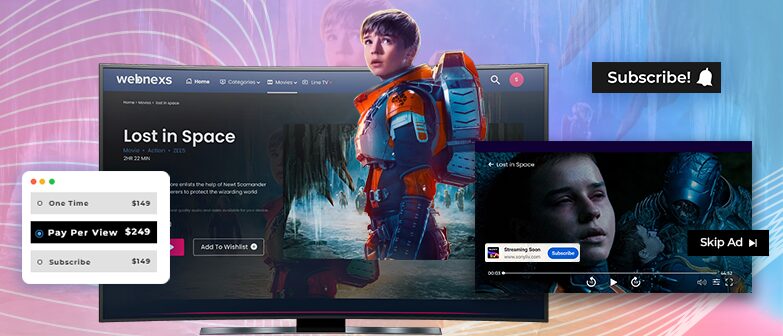


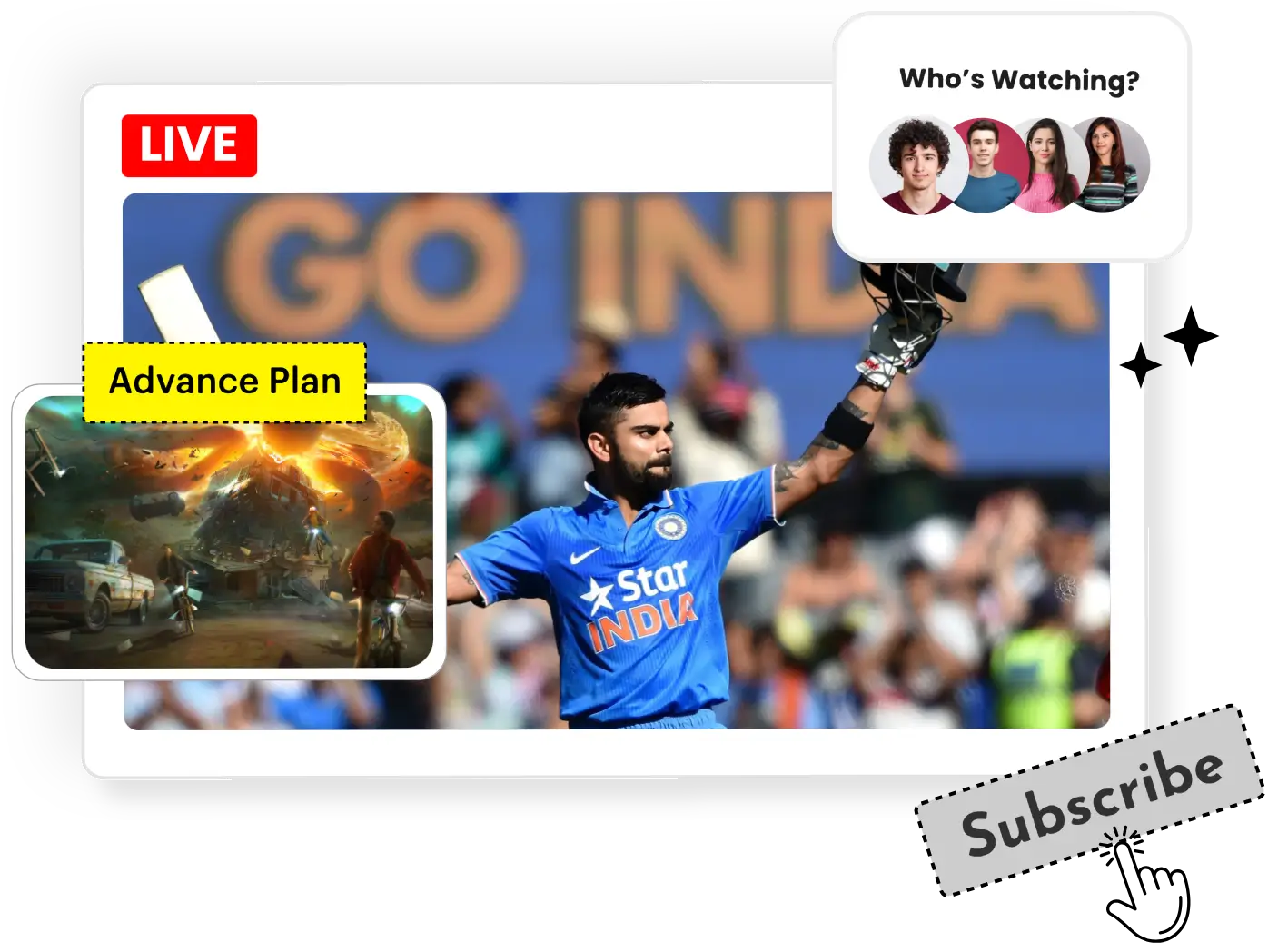
21 Responses
Glad that i am able to find out the benefits of AVOD,TVOD and SVOD
Got to know the basics of ott business models
Thanks for sharing! I finally understand how VOD platforms can impact the internet revolution and contribute to the OTT business model.
Good blog!!!!nice introduction of Avod , Tvod and SVOD
Understood the basics of ott business models
There are various ott business models for your online video platform but the best one is the subscription model(SVOD) as it is very popular and most of the online video platform providers make it a important one
Thank you for sharing the blog, which helps to shortlist the best one & get more information on ott business model for video streaming platforms . Keep on Posting!!
Best revenue building model list and it will be very useful for people who are looking to start an VOD business.
Thanks for sharing
Hello, I am an independent filmmaker in the US. I am planning to release two feature films online and monetize them using TVOD and AVOD options. I’d also love to learn more about how does revenue model of ott work?
Thanks for connecting. How many subscribers do you have? How many videos do you have ? You can schedule the call and discuss about your need in detail. Here is the link to schedule meet: calendly.com/webnexsdavid/30min
I have a question about pricing for TVOD services? I am interested in the EST & Permanent access
yes. you can allow users to watch the video for rental basis.. for renting 24 hours / 3 days / 7 days and so on. For more queries, schedule a call with our experts.
Thanks for this clear explanation. I was struggling to understand which OTT revenue model would suit a niche streaming service better.
Great article! Do these OTT business model support live streaming for events or sports content? Also, how does this fit into the OTT platform business model?
Thank you for your comment! Yes, many of the OTT business model listed, including Webnexs, support live streaming of events, sports, and more. You can easily integrate live streaming alongside on-demand content. For more information, please contact us at https://www.webnexs.com/contact-us.php.
This blog is very insightful! Can you clarify if the OTT business model listed support both live and on-demand streaming? Also, how do these platforms align with different OTT business models?
Thank you for your question! Yes, the OTT business models mentioned in the blog, including Webnexs, support both live streaming and on-demand content, offering flexibility to cater to diverse audience needs. For more details, feel free to contact us at https://www.webnexs.com/contact-us.php.
This was a great read! Do ott business models offer analytics to track user engagement and performance?
We’re glad you found the blog helpful! Yes, the OTT business models featured, including Webnexs, come with built-in analytics tools to track user engagement, content performance, and more. For details on specific analytics features, please reach out at https://www.webnexs.com/contact-us.php.
Loved this article! The comparison of each OTT revenue model really helps brands figure out the best monetization strategy for the future.
Very helpful! In today’s competitive market, understanding the strengths of each OTT revenue model is so important for success